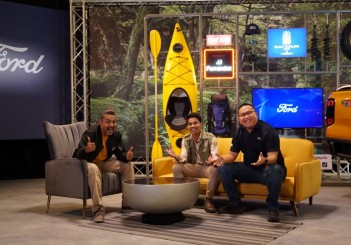While the love of overstatement is very much an American marketing thing, there is something to be said about seeing an iconic muscle car stretching its legs and venturing into a big bad world keen on fuel economy and nimble handling, and where big engines are levied with heavy taxes.
And, yet, there is something to be said about the allure of sticking the biggest engine you can find into the smallest, lightest 2-door-fits-four-or-more occupant chassis you can muster and pointing this rear-wheel drive vehicular Frankenstein in the direction of the straightest, longest stretch of tarmac.

It is an undisputed fact that the US is the birthplace of the muscle car.
Yet, there are differing schools of thought as to what the first muscle car was.
Some say it was the 1949 Oldsmobile Rocket 88.
Others say that the true golden age of the muscle car began with the introduction of the Pontiac GTO in 1964.
For many more – like this writer – the birth of the muscle car came as a result of the Ford Mustang.

While others have faded and then been revived, in a space of more than 50 years we have seen six generations of Mustangs.
When we say “we”, of course, we mean North Americans, mostly.
Ford did sell some to the Germans under the “T5” name (“Mustang” was owned by German firm Krupp and used for a line of trucks) and 250 lucky Australians were able to buy modified right-hand-drive Mustangs under a licensing deal.
All in all, Ford only sold 161,000 Mustangs overseas in five decades, or about 3,220 cars per year.
To show you how small a figure that is, by comparison, Perodua sold 17,584 cars in April this year alone.
That is changing with the imminent arrival of Ford’s first true global Mustang.

For Malaysia, the new Mustang is expected to hit local shores next year with an indicative price range of more than RM350,000 for the 2.3L EcoBoost variant and up to RM600,000 for the top of the range for the 5.0L V8 big daddy.
The latter is the one you want if you want to fulfil your Bullitt fantasies. This is also the variant that will make your banker and the Road Transport Department (JPJ) very, very happy.
Based on a few handy online calculators, that 5.0L pony car could be slapped with an annual road tax of RM11,130, while a RM600,000 price tag and a seven year loan (at 3.2% per annum) should set you back around RM6,428.57 per month.
It is okay to faint.
This writer did after seeing those numbers.

And, yet, that statement is not entirely true.
There was a British muscle car, Jensen Motor’s gorgeous Interceptor. Essentially an American V8 engine mated with an Italian-designed body, the Interceptor was a head-turner.
However, the car was doomed when Jensen Motors went into receivership in the mid-70s.
While production officially ceased in 1976, there have been several attempts to revive the car in the 1980s and 1990s, all of which failed.

However, it will cost you £180,000 (RM1.061mil) to own one.
Plus, its V8 Chrysler engine will mean that your annual road tax bill will set you back around RM19,230. Let us not go into how thirsty a V8 engine can get, lest we keel over from shock.
A more viable option, and located in a land very much like the US where there are plenty of straight roads and wide open blue skies, is Holden’s Monaro.
Three generations were built between 1968 and 1977, as well as 2001 and 2006, and they had all the right DNA.
Mostly powered by V8s (there were a few V6s and straight-sixes), these rear-wheel driven beauties were meant for the open road.
Loud, raucous but filled with creature comforts so that it can be used as an around town runabout.

A used third generation Monaro could fetch around the A$35,000 (RM99,000) mark.
We say relative because a Nissan Sunny in the early 2000s would set you back around A$20,000 (RM56,600).
Then again, a Sunny does not exactly come with a roaring V8 under the bonnet. Neither does it look like it chews up tarmac for fun - the Monaro did.
Of course, the ultimate Australian muscle car had to be a Ford, the Falcon Cobra to be exact.
Fitted with either a 5.8L or 4.9L V8 – depending on the production run that your vehicle came from – only 400 of these beauties were ever built.

Film buffs will know officer Rockatansky as “Mad Max”.
So, on the minus side, muscle cars are expensive to buy (if you are Malaysian), expensive to run and probably expensive to maintain.
On the plus side, though, when you are behind the wheel and the wide open road lies before you, there is nothing quite like it in the world.





















